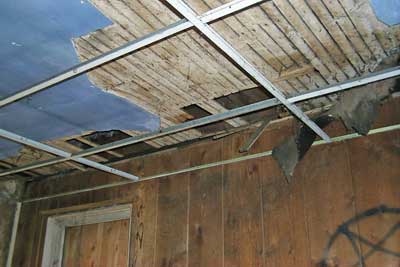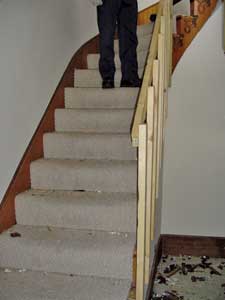<Previous Displaying 4/6 Page 1, 2, 3, 4, 5, 6 Next>
View Article as Single page
Combustible interior finishes. NFPA 1403, Appendix A …. Factors affecting “how NFPA 1403 is applied to a specific structure ….”
Section A.4.4.2 (10) states: Type of interior finish materials on the ceiling, walls, and floors. If combustible, they need to be accounted for in the fuel load evaluation, or they need to be removed. Combustible materials on the ceiling, wall or floor surfaces can lead to rapid transition to flashover.”
In older homes slated for demolition by fire departments, conservation groups and rehab contractors often remove oak and walnut staircases, baseboards, decorative window and door trim, crown molding, built-in shelving units or cabinets, light fixtures, stained glass or ornamental windows, doors, and fireplace mantles. In such cases, the training department has some work to do before live burn training can take place in the building.
Often the buildings possessing these architectural treasures are true masonry exterior walls with the floor joist cut on an angle at the joist pockets in the walls or they are of balloon construction with an opening from the basement to the attic when the baseboard or floor trim is removed. The salvagers can damage large sections of wall, floor, and ceiling. If allowing preservation and conservation folks to recover these things is a part of your AHJ’s permitting requirements, forcible entry tools like small halligans, officer tools, and a modified hydrant wrench may be less damaging than the tools the salvage folks use. Work with them to minimize the damage so your patching project will take less time.
If the house you’ve obtained has far less history in terms of décor, you may find low-density “gasoline” paneling, barn siding, paraffin wax-coated or vinyl wallpaper, car siding, or knotty pine tongue-and-groove with multiple coats of varnish or other materials. Mirrors, glass tile, carpet, artificial turf, burlap, simulated brick, felt, velvet, velour, and even polyethylene plastic sheeting have been found in structures set aside for fire training. As NFPA 1403 specifically addresses low-density combustible fiberboard, instructors will often debate the term “highly combustible interior finishes.” I remember many burns where the flaming 100-year-old waxed wallpaper would light off and fall down around us during the fire behavior lesson. This was before the common use of hoods in our PPE. The sudden volume of flame was just an accepted risk or object lesson for a trainee, and instructors were able to read the anxiety in the students’ eyes. Although effective “back in the day” in gauging whether a new student would activate the “fight or flight” reflex, it is (and admittedly was) an unacceptable adult education methodology.
If you’ve never seen the surface of a simulated brick wall covering flash off while advancing a line down a hallway, it might not “register” when preparing the 1970s family room of a house for burn training. If there is any doubt the wall surface could prematurely flash or add to the fuel load, remove it, cover it with drywall, or secure the room so it is not involved in the training exercise. My state’s history tells the story of concerns over such things in the tragedies at the Our Lady of the Angels school in Chicago, which occurred on December 1, 1958, and claimed the lives of 92 children and three nuns (http://bit.ly/1K4uY05) and St. Anthony’s Hospital, Effingham, Illinois, which occurred on April 4, 1949, and claimed the lives of 74 people (http://bit.ly/1wxRzZu).
Glass and plastic tiles and mirrors that appear to be ceramic are also of concern. Obviously, plastic tile will add to a less predictable fire load and flame spread as the increase in British thermal units generated in the same space will be dramatic. Although not considered a part of the fuel load, mirrored and glass walls pose an additional hazard. If thermal imaging technology is deployed, the reflective nature can interfere with the interior crew’s reading the conditions inside the structure. As these surfaces heat, crack, and break, they become a hazard to all parts of the body and the condition of the turnout gear and the SCBA. If you don’t remove these items prior to the burn evolution, they will break and come down at the most disadvantageous time.
Ceilings. They pose some risks when the plaster or gypsum board is badly cracked or sagging. Patch holes left after the removal of light fixtures, decorative beams, or crown molding. Cover above and below the opening vents passing through the ceiling that were used in the past to allow heating the floor above so that fire does not travel upward or firefighters fall through.
False ceilings, suspended or drop ceilings, or “tile” ceilings, popular for various reasons in the 1970s and 1980s, can present dangers when fire training. False ceilings framed out and covered with drywall provide a dead air space where fire, smoke, and heat can become trapped. If the plaster and lath above it is breached or damaged, it will add to the fuel load and allow fire to travel in essentially two dead air spaces. If the subsequent overhaul through two layers of ceiling, at two separate heights, is not part of the planned objectives for a drill in that room, the training for that day will be overhaul work (photo 7).

Suspended ceilings with wire attachments to ceiling rafters or second-level floor joists pose a similar problem. Often, attaching the hangers to the original plaster ceiling caused damage that allowed fire to travel. The likelihood of canned or fluorescent light fixtures are part of the newer ceiling, meaning that above are additional breaches made to accommodate the wiring process. Depending on their locations in the property, insulation as well as metal or flexible “helix” style HVAC conduit may have been added. If left in place, their potential failure in a live fire exercise may injure responders or cause them to become trapped.
The ceiling panels are an additional concern from the perspectives of their combustible nature and weight. Fire rated panels are unusual in single-family dwellings. Even if the suspended ceiling was completely fire rated, it is not safe to keep the drop ceiling intact. Some panels in the field were found to be manufactured of fairly rigid insulation coated with a vinyl or plastic decorative surface. When ignited early in the incipient phase, the material behaved as if the surface were coated with napalm. You must discover this before the training. The surface will ignite and drip like gasoline or flaming candle wax.
The additional work of pulling down the panels, framework, wires, and fixtures are warranted to make conditions during the fire training safer. There have been many reports of firefighters getting caught in the wiring, fixtures, and helix style HVAC conduit when ceilings came down during the fires
Another commonly found ceiling configuration includes 12- × 12-inch fiberboard tiles on 1- × 2-inch furring strips. Conducting burns where this type of ceiling was left in place produced mixed results. If the grid was in good condition with all squares in place, it tended to slowly decompose with some flame near the edges. Once a tile was lost, fire equal to the depth and length of the squares and furring strips traveled slowly in the dead air space. When tiles were used to cover existing drywall or plaster, the results were usually easily controlled. If it was a standalone ceiling, fire often rapidly extended to the attic or floor space. Eliminate the potential hazard by removing the fiberboard tile ceiling and recovering it with drywall.
Stairways. When preparing the structure, pay attention to stairways to all levels, whether interior or exterior and whether covered by a hinged floor board on a “mud porch”; a treated lumber exterior deck supported by questionable 4- × 4-inch beams; or a formal staircase with decorative trim, balusters, and railings. These structures were acceptable for day-to-day living in a one- or two-family dwelling. Blatantly obvious is the need to replace stair treads or railings when a reclamation contractor has removed the fancy walnut staircase. If they are still present in the building, ensure that the existing stairs, balusters, and railings will handle the repeated movements of firefighters and their equipment up and down the stairways (photo 8).

Outside staircases to cellars and basements pose a risk. Constantly exposed to weather and not often used, the doors, treads, and risers may be rotted and railings may be missing. If a window is to be used as a secondary exit over the “lean to” access door, ensure that the door can support the sudden live load of a responder escaping through the window.
As you descend to the cellar in the preparation phase, look for insect hives, raccoon nests, and nontraditional tread and riser heights and widths. During the training phase, make sure the door is closed so that no one falls in; however, if checking the basement for extension, secure it open. Someone may have to monitor the opening at ground level to direct people away if the training evolution is ongoing
Many times, the acquired structures are in rural areas where building codes are either nonexistent or not enforced. Staircases or decks added on to structures usually were constructed with cost savings in mind; the needed structural support for emergency response staff may be marginal. Completely remove the additions if the integrity of the construction is suspect. Secure the doors or windows normally used to access the area to avoid a fall. Training sessions have necessitated rebuilding stairs of some kind to minimize the trip and fall hazards. If the footwork is done early and the property owner allows access early, search and rescue and hose and ladder training can take place in nonfire conditions. Identify the areas that need reinforcing for the live fire exercises at that time.
<Previous Displaying 4/6 Page 1, 2, 3, 4, 5, 6 Next>
View Article as Single page
Fire Engineering Archives


